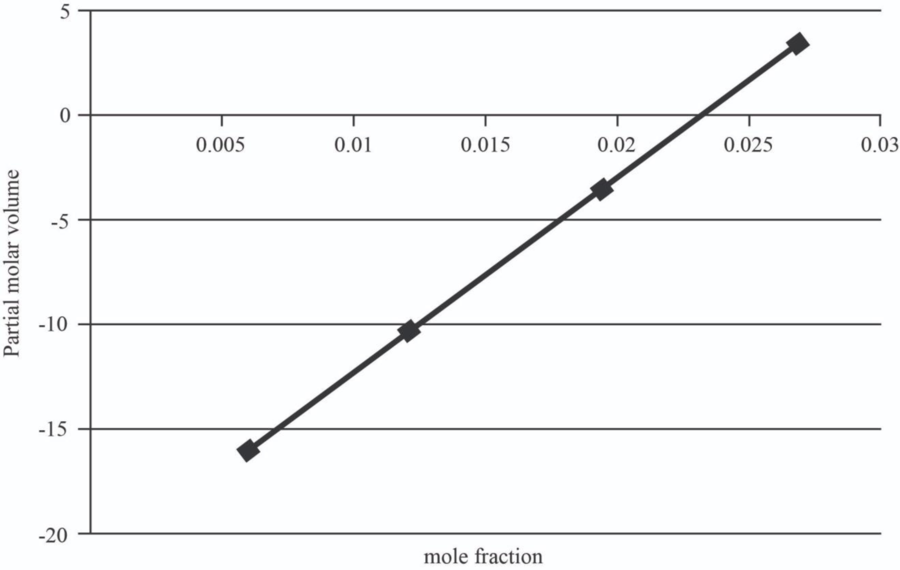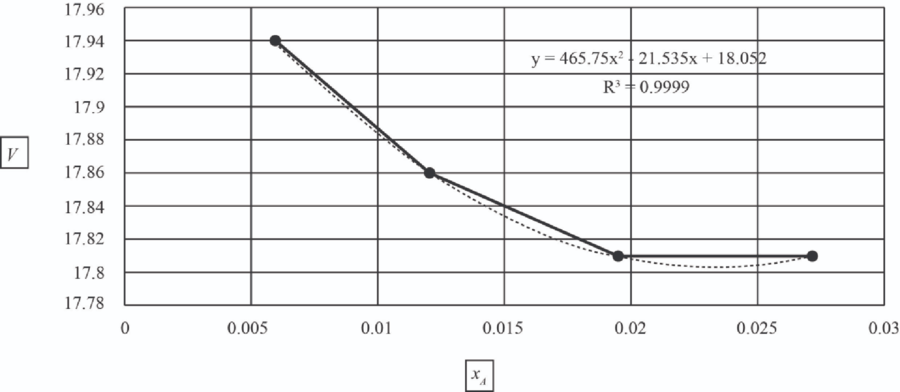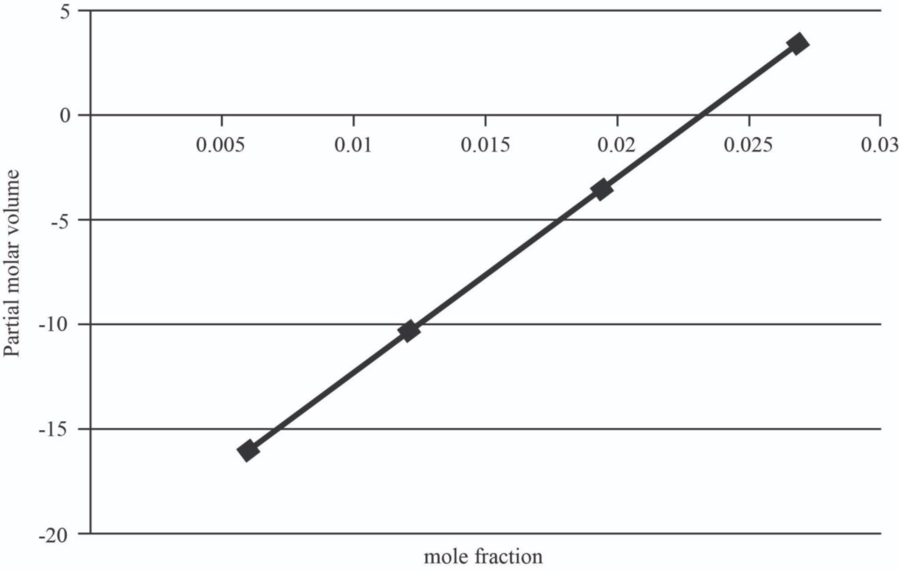
Concept explainers
Interpretation:
The partial molar volume of
Concept Introduction:
The partial molar volume is the contribution that a component of mixture makes to the total volume of a sample. The partial molar volume of a substance is expressed as,
Answer to Problem 5A.5P
The partial molar volume of
| 5 | 1.0151 | 0.006 | -15.946 |
| 10 | 1.107 | 0.012 | -10.357 |
| 15 | 1.167 | 0.0195 | -3.37075 |
| 20 | 1.23 | 0.027 | 3.6155 |
The graph between mole fraction of

Figure 2
Explanation of Solution
The data of mass densities of aqueous solution of
| 5 | 1.0151 |
| 10 | 1.107 |
| 15 | 1.167 |
| 20 | 1.23 |
The moles of
The molar mass of
Substitute the molar mass of
The density of the solution (
Where,
Therefore, the molar density of the solution (
Where,
The volume of the solution is given by the formula below.
The mass of the solution is
Substitute the value of mass of solution in (3).
Substitute the value of
The mass of water (
Substitute the value of
The total molar volume of the solution (
Substitute the value of
The mass of
The density (
The molar mass of
The molar mass of
Substitute the value of
The mole fraction of
The mass of
Substitute the mass of
Similarly the values of
| 5 | 1.0151 | 0.006 | 17.94 |
| 10 | 1.107 | 0.012 | 17.86 |
| 15 | 1.167 | 0.0195 | 17.81 |
| 20 | 1.23 | 0.027 | 17.81 |
The values of

Figure 1
The data was fit to a second order polynomial using the POLY program to generate the equation given below.
The partial molar volume of a substance (
Where,
Differentiate equation (9) with respect to
Substitute the value of
Similarly the values of
| 0.006 | -15.946 |
| 0.012 | -10.357 |
| 0.0195 | -3.37075 |
| 0.027 | 3.6155 |
The graph between mole fraction of

Figure 2
Want to see more full solutions like this?
Chapter 5 Solutions
Atkins' Physical chemistry
- Help me solve this problem. Thank you in advance.arrow_forward22.7 Predict the monoalkylated products of the following reactions with benzene. (a) AlCl3 Ya (b) AlCl3 (c) H3PO4 (d) 22.8 Think-Pair-Share AICI3 The reaction below is a common electrophilic aromatic substitution. SO3 H₂SO4 SO₂H (a) Draw the reaction mechanism for this reaction using HSO,+ as the electrophile. (b) Sketch the reaction coordinate diagram, where the product is lower in energy than the starting reactant. (c) Which step in the reaction mechanism is highest in energy? Explain. (d) Which of the following reaction conditions could be used in an electrophilic aro- matic substitution with benzene to provide substituted phenyl derivatives? (i) AICI3 HNO3 H₂SO4 K2Cr2O7 (iii) H₂SO4 (iv) H₂PO₁arrow_forwardIs an acid-base reaction the only type of reaction that would cause leavening products to rise?arrow_forward
- Help me understand this! Thank you in advance.arrow_forward22.22 For each compound, indicate which group on the ring is more strongly activating and then draw a structural formula of the major product formed by nitration of the compound. Br CHO (a) CH3 (b) (c) CHO CH3 SO₂H (d) ☑ OCHS NO₂ (e) (f) CO₂H NHCOCH3 NHCOCH, (h) CHS 22.23 The following molecules each contain two aromatic rings. (b) 000-100- H3C (a) (c) Which ring in each undergoes electrophilic aromatic substitution more readily? Draw the major product formed on nitration.arrow_forwardV Consider this step in a radical reaction: Br: ? What type of step is this? Check all that apply. Draw the products of the step on the right-hand side of the drawing area below. If more than one set of products is possible, draw any set. Also, draw the mechanism arrows on the left-hand side of the drawing area to show how this happens. ⚫ionization termination initialization neutralization none of the abc Explanation Check 80 Ο F3 F1 F2 2 F4 01 % do5 $ 94 #3 X 5 C MacBook Air 25 F5 F6 66 ©2025 ˇ F7 29 & 7 8arrow_forward
- Show how to convert ethyl benzene to (a) 2,5-dichlorobenzoic acid and (b) 2,4-dichlorobenzoic acid.arrow_forwardno aiarrow_forwardPolymers may be composed of thousands of monomers. Draw three repeat units (trimer) of the polymer formed in this reaction. Assume there are hydrogen atoms there are hydrogen atoms on the two ends of the trimer. Ignore inorganic byproducts.arrow_forward
 ChemistryChemistryISBN:9781305957404Author:Steven S. Zumdahl, Susan A. Zumdahl, Donald J. DeCostePublisher:Cengage Learning
ChemistryChemistryISBN:9781305957404Author:Steven S. Zumdahl, Susan A. Zumdahl, Donald J. DeCostePublisher:Cengage Learning ChemistryChemistryISBN:9781259911156Author:Raymond Chang Dr., Jason Overby ProfessorPublisher:McGraw-Hill Education
ChemistryChemistryISBN:9781259911156Author:Raymond Chang Dr., Jason Overby ProfessorPublisher:McGraw-Hill Education Principles of Instrumental AnalysisChemistryISBN:9781305577213Author:Douglas A. Skoog, F. James Holler, Stanley R. CrouchPublisher:Cengage Learning
Principles of Instrumental AnalysisChemistryISBN:9781305577213Author:Douglas A. Skoog, F. James Holler, Stanley R. CrouchPublisher:Cengage Learning Organic ChemistryChemistryISBN:9780078021558Author:Janice Gorzynski Smith Dr.Publisher:McGraw-Hill Education
Organic ChemistryChemistryISBN:9780078021558Author:Janice Gorzynski Smith Dr.Publisher:McGraw-Hill Education Chemistry: Principles and ReactionsChemistryISBN:9781305079373Author:William L. Masterton, Cecile N. HurleyPublisher:Cengage Learning
Chemistry: Principles and ReactionsChemistryISBN:9781305079373Author:William L. Masterton, Cecile N. HurleyPublisher:Cengage Learning Elementary Principles of Chemical Processes, Bind...ChemistryISBN:9781118431221Author:Richard M. Felder, Ronald W. Rousseau, Lisa G. BullardPublisher:WILEY
Elementary Principles of Chemical Processes, Bind...ChemistryISBN:9781118431221Author:Richard M. Felder, Ronald W. Rousseau, Lisa G. BullardPublisher:WILEY





